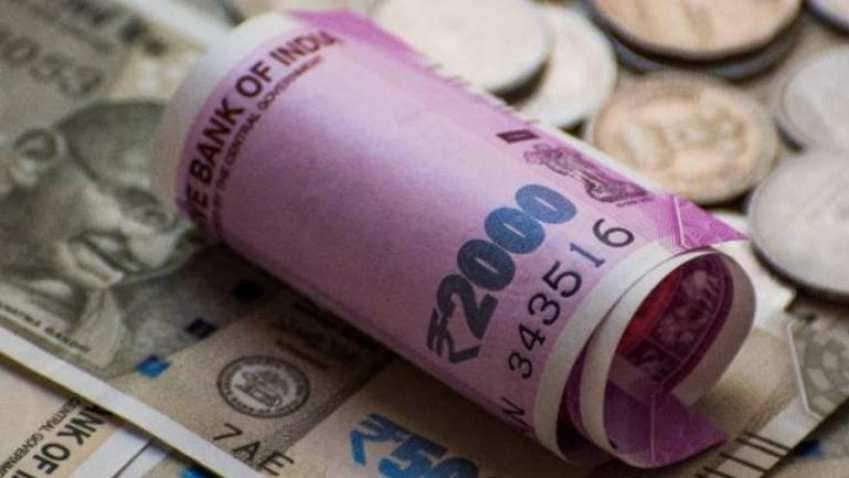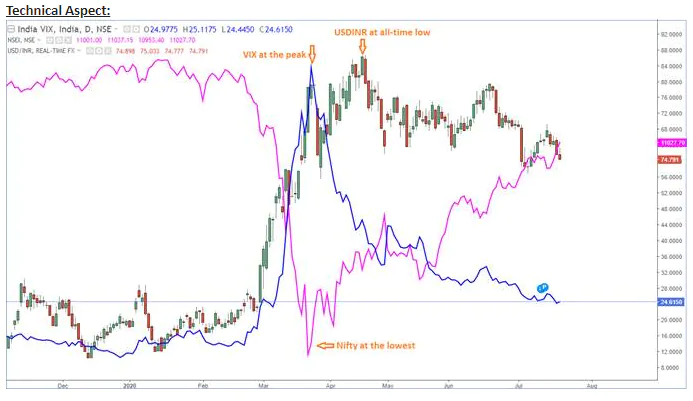- July 22, 2020
- Posted by: Amit Pabari
- Category: Currency

The resilience of the rupee can be best seen from the current month’s behavior. This month India try has witnessed an outflow of $1.2 billion so far and RBI has bought approximately $9 billion reserves taking it to $516.36 billion. Despite global risk-off mode, outflows from the Indian capital markets and vigorous buying by RBI, the rupee has remained on a stable to positive note possibly backed by a chunk of corporate inflows flooding in the country. We have been mentioning in our last few reports, the domestic reasons why we see rupee not depreciating towards 80 and on the contrary, expecting the pair to rise near 73.50 levels.
However, one known yet unknown global factor about the dollar can play its cards this time which can turn out to be a supporting factor for the rupee. The dollar has always been considered as a safe haven i.e. when risk grips the market; the dollar is bound to rise and vise-versa. Contrasting to its nature, this time the US dollar seems to have losing its allure as a “haven asset.”
The reason for the decline in the value of the dollar in the near future can be stated as below:
· Decline in dollar swap line by Fed: There had been a net outflow of dollars throughout the pandemic, peaking up in March and April which was led by heavy equity sell-off. This brought in the shortage of dollars which later, was apparently satisfied by swaps lines served up by the Fed in its March and April efforts to supply liquidity to financial markets across the globe. Two types of swap lines were established: dollar liquidity lines and foreign-currency liquidity lines. The dollar swap lines helped to improve liquidity conditions in dollar funding markets in the US and abroad by providing foreign central banks with the capacity to deliver US dollar funding. These arrangements proved to ease strains in financial markets and mitigate their effects on economic conditions, thereby serving as a prudent liquidity backstop. However, off late, the use of this swap facility has dropped back significantly and the net outflow of funds has declined as cautiousness took over panic in the market.
· Gold preferred over US Dollar: The spike in monetary inflation as a result of the massive monetary policy easing and rapid money creation from the central bank could result in more price inflation. The monetary inflation could also result in a weaker dollar. A weaker dollar and high liquidity could result in higher commodity prices as well and therefore could be inflationary. Gold is known for preserving purchasing power and a wise hedge against inflation, it will become a preferred safe haven asset over the dollar in such times.
· Unfulfilling economic recovery: The assumption that still hangs over the future path of the economic recovery is that the US stock market recovery will be V-shaped and will return to previous levels of activity in 2021. However, after opening up the US economy the recovery of the country has fallen short as the COVID-19 cases have shown steady increases. In other areas of the world, for example in the European Union, economies are opening up and appear to be moving on in better shape than what is being experienced in the US. As other countries are now expected to grow relatively faster than the US, their currencies are bound to rise thereby weakening the dollar.
Generally, any sort of crisis gets dollar stronger but this time due to the above mentioned factors and rising COVID-19 cases the dollar is likely to weaken. However, there might be occasions of spikes arising out of known-unknown factors in the dollar index which are likely to be short-lived.
As seen above, the Volatility index (blue line) was at the peak at 86.63 during the month of March when Nifty (Pink line) bottomed near 7600 levels in the year and Rupee (Candles) declined to an all-time low near 76.90 levels. This indicates that the risk-off mode and the fear were at the highest levels which lead to an increase in the volatility, sell-off in the equity and weakening of rupee. Eventually, the course of all three indicators seems to have changed. The VIX normalized to around 24.50 levels, Nifty retraced back near 11000 and Rupee strengthened close to 74.90 levels. All of these indicate a shift of sentiments and revival of risk-on mode in the Indian market.
Outlook:
The above fundamental and technical indicator hints towards rupee appreciation. Given the reasons mentioned above and our previous articles, there is a higher possibility that the pair would move near 73.50 levels in the next 5 to 6 months. However, any uptick close to 75.50-60, arriving out of unprecedented news or event shall remain a selling opportunity for the near term.
Strategy:
Strategy for Export: Exporters having new orders are suggested to sell on every uptick close to 75.50 levels. For those who are keeping the positions open are advised to follow a strict stop-loss of 74.50 or cost whichever is higher.
Strategy for Imports: Importers can buy payments till mid-August close to 74.50 levels. To hedge more than a month, they can buy at the money call option in order to keep the downside open.
-Amit Pabari is managing director of CR Forex Advisors. The views expressed are personal.
Leave a Reply
You must be logged in to post a comment.





